
Juncus acutus, the spiny rush, sharp rush or sharp-pointed rush, is a flowering plant in the monocot family Juncaceae. It is native to the Americas, Northern and Southern Africa, Western and Southern Europe and West Asia, and is found in a variety of wet habitats, such as bogs, fens, meadows, and salt marshes, and along the edges of ponds and lakes.

Juncus articulatus is a flowering plant species in the rush family Juncaceae. It is known by the common name jointleaf rush or jointed rush, which can also refer to J. kraussii from Australia. It is native to Eurasia, Canada, Greenland, and much of the United States. It grows in moist areas, such as wet sand, and thrives in calcareous soils. J. articulatus was found to be more sensitive to drought and salt stress than its congeners J. acutus and J. maritimus. It is a perennial herb producing mainly erect stems from a short rhizome. The stem may root at nodes, and it generally has one or more flattened hollow cylindrical leaves up to 10 centimeters long. Transverse internal partitions or joints may be seen or felt in the leaf of the plant.
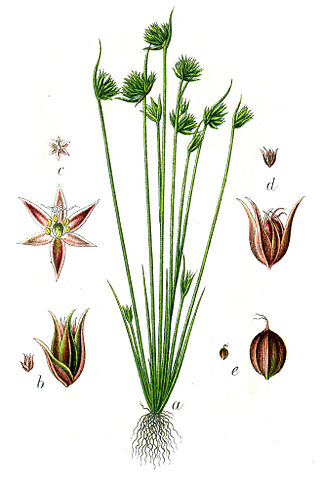
Juncus capitatus is a species of rush known by the common names dwarf rush and leafybract dwarf rush. It is native to Europe, Asia and North Africa. It is also an introduced species in parts of North America such as California and the Gulf Coast. It grows in moist areas, such as wet sand, vernal pools, and ditches.

Juncus mexicanus is a species of rush known by the common name Mexican rush. It is native to the southwestern quadrant of the United States and parts of Mexico and Central and South America. It is a plant of moist areas in a great number of habitats, from coast to desert to mountain and low to high elevation.

Juncus patens is a species of rush, known by the common names spreading rush and California grey rush.

Juncus dubius is a species of rush known by the common name wrinkled rush. It is endemic to California, in the California Coast Ranges, Transverse Ranges, and southern Sierra Nevada. It is a common member of the flora in many wet areas, such as marshes and riverbanks.
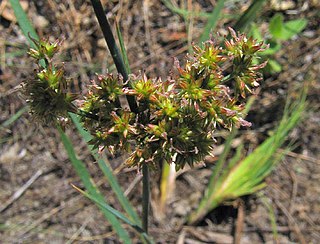
Juncus xiphioides is a species of rush known by the common name irisleaf rush.

Chaenactis glabriuscula, with the common name yellow pincushion, is a species of flowering plant in the daisy family. It is native to California and Baja California.
Juncus triformis is an uncommon species of rush known by the common names Yosemite dwarf rush and long-styled dwarf rush.

Lessingia germanorum is a rare species of flowering plant in the family Asteraceae known by the common name San Francisco lessingia. It is endemic to California, where it is known from four populations in the Presidio of San Francisco and one occurrence on San Bruno Mountain south of San Francisco. It is a state and federally listed endangered species. The already rare plant is endangered by many processes, including invasive species, development, sand mining, off-road vehicles and bulldozers, habitat fragmentation, trampling, and pollution, as well as stochastic events.
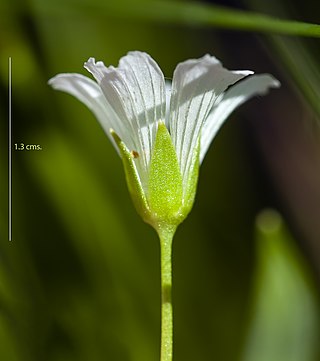
Limnanthes bakeri is a rare species of meadowfoam known by the common name Baker's meadowfoam. It is endemic to Mendocino County, California, where it is known from only about 20 occurrences in the vicinity of Willits. It is a plant of wet, grassy habitat such as vernal pools and marshy spring meadows.
Plagiobothrys strictus is a rare species of flowering plant in the borage family known by the common name Calistoga popcornflower. It is endemic to Napa County, California, where it is known from only two small locations near Calistoga.
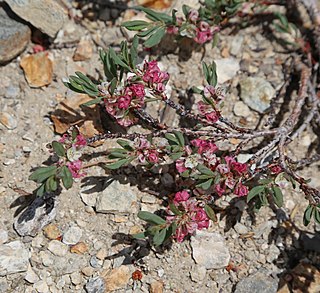
Polygonum shastense is a species of flowering plant in the knotweed family known by the common name Shasta knotweed. It is native to sections of southwestern Oregon, northwestern Nevada, and northern and central California, where it grows in rocky and gravelly mountainous habitat up to 3300 meters (11,000 feet) elevation. It is most common in the Sierra Nevada. The species name refers to its occurrence on Mount Shasta in Shasta County, California.
Puccinellia howellii is a rare species of grass known by the common name Howell's alkaligrass. It is endemic to Shasta County, California, where it is known from a single population in Whiskeytown National Recreation Area near Whiskeytown. Its entire population is contained in a 1-acre (4,000 m2) complex of three saline mineral springs directly next to Highway 299. The grass was first described to science in 1990 and no other populations were discovered despite extensive searches of the area.

Streptanthus longisiliquus is a species of flowering plant in the mustard family known by the common name long-fruit jewelflower. It was first described to science in 2007. It is endemic to northern California, where it is known from Butte, Tehama, and Shasta Counties. It can be found in forest and woodland habitat in mountains and foothills. It is a short-lived perennial herb producing a few-branched stem up to 1.2 to 1.5 meters in maximum height. It is mostly hairless except for some light hairs on the inflorescences and sometimes the leaf petioles. The basal leaves have oval or spoon-shaped blades up to 10 centimeters long, usually with smooth edges. Leaves higher on the stem are oval or oblong and lack petioles, their bases often clasping the stem. Flowers occur at intervals along the upper stem. Each flower has a bell-shaped calyx of sepals which yellow-green at the base and purplish at the tip, measuring under a centimeter in length. The petals emerging from the end are brownish or purplish with greenish bases. The fruit is a flattened, curving silique that can be quite long even for the genus, measuring up to 15 centimeters in length.

Streptanthus vernalis is a rare species of flowering plant in the mustard family known by the common name early jewelflower. It was first observed in the 1970s but not actually described to science until 2005. It is endemic to Lake County, California, where it is known from a single occurrence at Three Peaks near the Napa County line. It is apparently limited to serpentine outcrops in forested and chaparral habitat. Genetic analysis indicates that the species is distinct from other Streptanthus and is most closely related to Streptanthus morrisonii, which it resembles. It is a hairless annual herb producing an erect branching or unbranched stem 2 to 20 centimeters tall. The ephemeral basal leaves have thick, fleshy leaves which are green and unmottled on top and purple on the undersides. Leaves higher on the stem are linear to lance-shaped and lack petioles. Flowers occur at intervals along the upper stem. Each flower has an urn-shaped calyx of sepals which is solid green with no purple or yellowish tinge. The petals emerging from the tip are white without darker veining. The fruit is a flattened straight silique 3 to 5 centimeters long containing orange seeds.
Boechera yorkii is a rare species of flowering plant in the mustard family known by the common name Last Chance rockcress. It is endemic to Inyo County, California, where it is known only from the Last Chance Range in Death Valley National Park. There are only two occurrences known, but the plant occurs in remote, nearly inaccessible mountain territory, so more plants may exist unobserved. The species was only described to science in 2004. Its habitat is rocky mountain canyons on cliffs of dolomite.

Calochortus syntrophus is a rare species of flowering plant in the lily family known by the common names Callahan's mariposa lily and clustered mariposa lily. It is endemic to northern California, where it occurs in a remote area north of Montgomery Creek in Shasta County. It has also been spotted in adjacent Tehama County. Its habitat includes open, rocky areas with moist or wet soils in oak woodland territory. It was first discovered in 1993 and its description was published the following year.

Deinandra conjugens is a rare species of flowering plant in the family Asteraceae known by the common names Otay tarplant and Otay tarweed. It is native to a small section of far northern Baja California in Mexico, its range extending north into San Diego County, California, in the United States. One isolated population has been reported from the hills east of Cayucos in San Luis Obispo County.
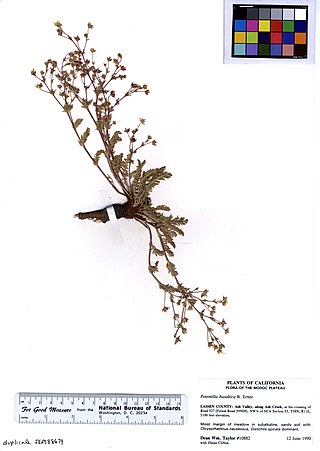
Potentilla basaltica is a species of flowering plant in the rose family known by the common names Soldier Meadows cinquefoil and basalt cinquefoil. It is endemic to a small area of the Modoc Plateau and Warner Mountains in northeastern California and northwestern Nevada.
















